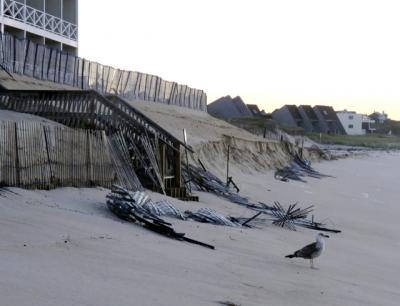Army Corps Rethinking Montauk Beach Project

The United States Army Corps of Engineers, which had set Monday as the start date for construction of a wall of sandbags across the downtown Montauk ocean shore, told a federal court judge on Thursday that it is reassessing the area to determine “whether there have been additional erosion issues,” and that construction has been pushed back until Thursday at the earliest.
The Corps, along with East Hampton Town and New York State, had been ordered to appear before the court on Friday as Judge Anne Y. Shields of Eastern District Court considered a request by a group of East Hampton Town residents suing to stop the project for an injunction preventing the start of the reinforced dune construction.
Defend H2O, an environmental organization, along with several individual Montauk residents, filed a lawsuit in May claiming that the dune, designed to protect the shoreline structures along a 3,100-foot stretch of the downtown beach, is a “hard structure” that will cause further erosion of the beach, and is barred by East Hampton Town’s local waterfront revitalization project plan.
In light of the need for a new site survey, the Army Corps asked Judge Shields, in a letter, to postpone the hearing on the injunction until Wednesday, “when the Corps expects to have completely analyzed the erosion surveys.”
According to Kevin McAllister, the founder of Defend H2O and a principal in the lawsuit, the judge instructed the Army Corps to submit its response to the injunction request by Tuesday. Mr. McAllister said in an email that he feels “very confident” that the preliminary injunction will be issued. The court order could put the project on hold until the lawsuit can be adjudicated.
Contractors hired for the $8.9 million project – at federal expense under a post Hurricane Sandy emergency action authorization – set up shop at Montauk’s Kirk Park at the beginning of the month, as a staging area.
Early last week, after storms and wind during the previous weekend, the ocean shore in Montauk’s downtown appeared far narrower than the width of the artificial dune as depicted on specifications showing the wall of sand-filled geotextile bags piled in a slope up to a 15 1/2-foot height, and sloping down again toward the water. Pedestrian walkways on pilings are to be built over the dune.
